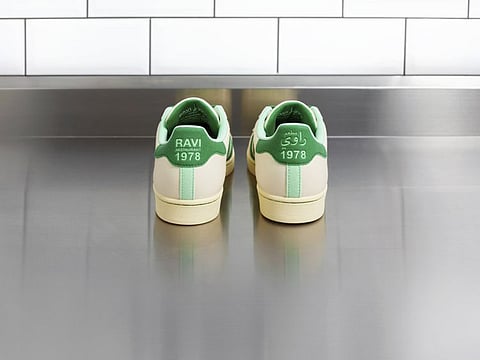adidas’ tribute to Ravi’s is as much about Dubai’s way of life
What adidas did with Ravi’s shines through as hearteningly genuine and that matters

Many of you will have heard of a place called Dubai. If you haven’t been, your impression of it is probably shaped by a BBC Dubai-related documentary, where it’s named ‘the Vegas of the Middle East’ or ‘the playground for the rich.’
Many of you will not have heard of Ravi’s.
Ravi’s is a Pakistani restaurant established in 1978 in the heart of ‘proper’ Dubai: Satwa. Now it’s quite hard to form an equivalence for those who haven’t spent any time in Dubai. For parity’s sake, it’s got the same kind of cult status of Morley’s in South London or In-n-Out Burger in California. But the important thing to know is that Ravi’s is not a chain, and it certainly isn’t fast food. In fact, Ravi’s is the complete antithesis of what you’ll have seen in a BBC documentary in that it’s an aspect of my hometown I’m proud of.
Which is why, when adidas decided to partner with Ravi’s — along with 11 other community-driven restaurants in 11 cities around the world, creating an Originals series shoe called ‘adilicious’. Having spent my formative years in Dubai, this ‘collab’ has completely partnership blew my mind. And in its success, it’s bucked every trend we ad folk have been told to follow.
It’s not ‘culture fast’, it’s culture SLOW
As an industry, we’ve fixated on ‘tapping into culture’ or creating comms ‘at the speed of culture’, which is great in theory. In practice, we’re only actually tapping into what’s trending on TikTok or twitter that day. This is limited to reacting to cultural events that work at the speed of our news cycle; it relies on influencers, platforms, or current affairs. It also mean you’re just as quickly forgotten.
This partnership does the opposite. By going after long-standing cultural institutions which have existed and contributed to the vibrancy of city life for decades, adidas will create legitimate long-term relevance and desire. By chasing the more robust side of culture — slow culture (culture that really matters) the brand may be rewarded by staying remembered for longer.
The collision of difference as a path to authenticity
This is not new. Primark (street fashion) might have partnered with Greggs (food chain) earlier this year, but something about adidas x Ravi’s partnership hits differently. Why? It’s what these brands stand for which makes this story so rich.
This is adidas, a brand that has had global influence over street culture for years, using its platform to give recognition and voice to a fellow yet hitherto globally unsung experts in street culture in 12 different places. In the case of Ravi’s, it’s been an integral part of ‘authentic’ Dubai since 1978. Yet, it’s never been celebrated or recognised for the colour and joy it brings to the community. This collision has a bit of a Cinderella story to it, which make you want to champion it more.
The lesson? Don’t be afraid to go after an unsung hero: it will pay off.
Backing culture that provides comfort is good for social cohesion
Ravi’s is an institution. It’s somewhere mum would take us when we had something to celebrate. It’s where we’d go to meet friends. Birthdays. After funerals. You could feed four for under a tenner while watching the bustling downtown part of the city go by. Ravi’s was always there, and it never changed — and that’s what you want when the world’s a bit topsy-turvy.
So, when a big brand wants a part of the Ravi magic, it does an enormous amount for social cohesion. Why? When the thing that you love, that’s held everyone together over many years, succeeds — you feel a sense of pride. And if your fellow city pals also rally behind it, you experience a bond. That feeling of togetherness is priceless, particularly in our age of division.
Your brand had more power than you think it does to bring people together, so don’t shy away from that potential.
It’s truly ‘glocal’
It doesn’t get much better than a big brand collaborating with a small, deeply embedded cultural institution. It drives relevance amongst an engaged street audience, guaranteed, but it will also ripple through UAE society more generally. The quite bizarre choice of collaborating with a restaurant is strange on the surface, but it does make sense. Food can transcend physical borders and create cross-cultural bonds. That’s what Adidas is all about.
Even in the case of a big global brand, it means far more to people in their localities. So ideate once, localise a thousand times.
It didn’t come from ‘ooooh, big data’
No amount of social listening or creeping on a nation’s internet data could have helped birth this concept. This idea relied on a good old-fashioned, data collection method: talking to people. The success of this lies in strong local knowledge that intersects several communities, where the heart of ‘street culture’ lies. In our fascination with ‘oooh big data’, this collab is a reminder that we shouldn’t forget how to live life, or just get out there, as a way of getting hold of insights.
This collaboration shows that you do not have to jump on a fickle trend first to successfully tap into culture. Capturing slow culture the way Adidas has is more meaningful than a few likes or shares that come with the next TikTok trend. So give slow culture a proper chance. It might help your brand create a longer-lasting mark on the culture it lives and breathes in.
I like adidas more now. I have never wanted a set of trainers more than I have these. But really, I have never wanted to be sat on the Ravi’s pavement more than I have now.
Sign up for the Daily Briefing
Get the latest news and updates straight to your inbox






